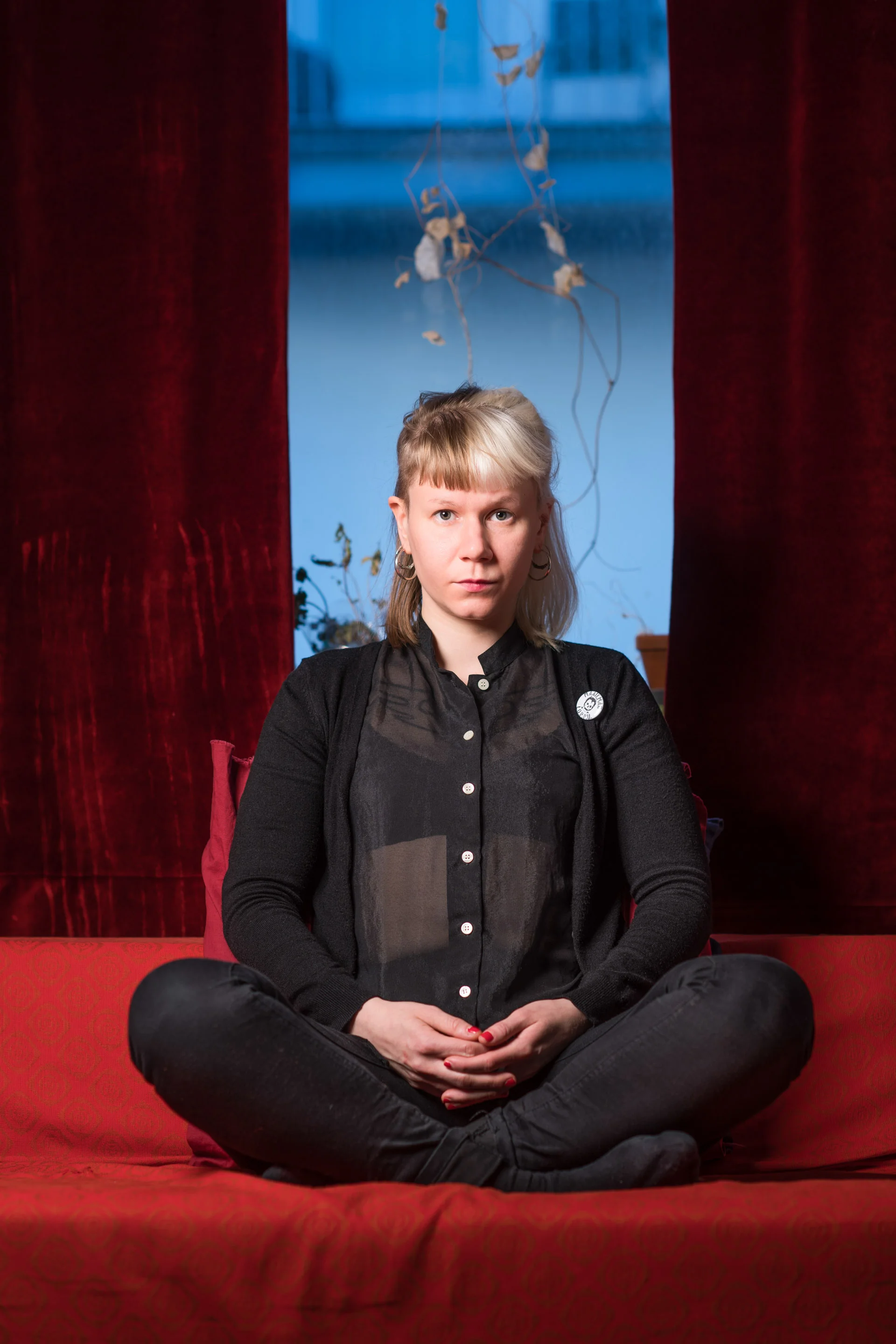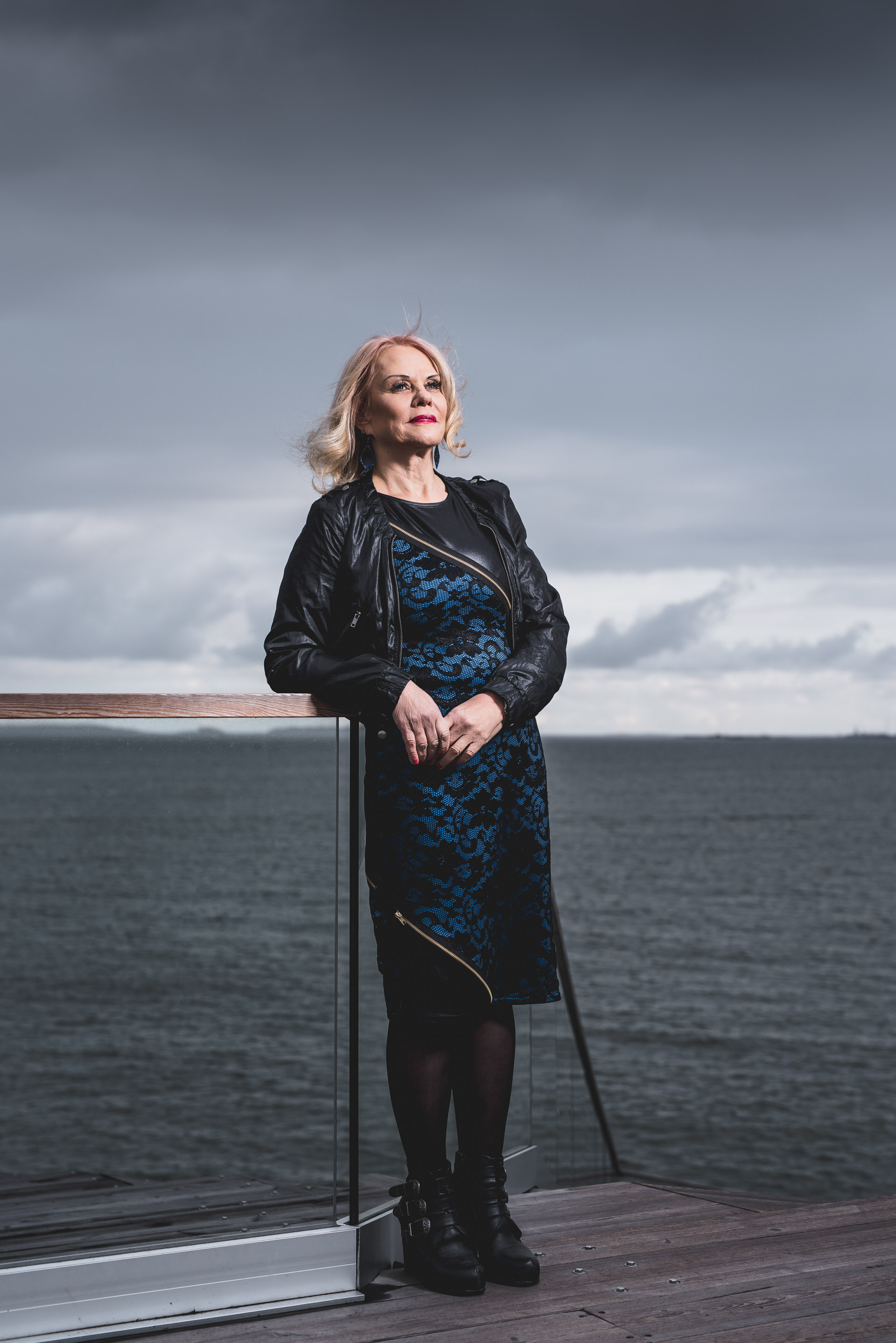YOU ARE HERE NOW
How does one get to be seen as a person by others?
The photographer gazes, but can he see? This question transports us to the very core of portrait photography. Does the photographer capture the soul of his or her subject? Is he or she photographing him/herself or something else?
In his exhibition You Are Here Now (Olet nyt tässä), Antti Kirves has portrayed 20 people who share amongst them the common trait of looking the way they are. They are as they want to be, and they show this as they want to show it: by sporting lumberjack shirts or leather boots.
There is something in Kirves’s photographs that speaks about being human, about feeling at home in oneself. It is more than just wearing clothes that fit your values. A person’s appearance communicates his or her relationship with the world. To not care about what others think is a choice, an attitude even. Choosing one’s clothes is often a series of deliberate choices deeply rooted in one’s own identity.
To look at Kirves’s photographs is to look at him. In some way the photographs are his self-portraits, as straightforward and ordinary as they are delicate and complex.
As photographers, we filter everything through our personality – at least whenever we get the opportunity to make personal decisions about how we wish to tell our story.
Thus, it would be intriguing to think that perhaps portraits indeed are reflections of us, the photographers. However, the truth is in connecting: It has been said that a portrait of another person is never the photographer’s self-portrait – but it is not a “true” image of the subject either. It has also been said that a truly soulful photograph can only come to be in a space in which both the photographer and the subject are present. Only then will the photograph truly be unique.
Hannamari Shakya
Photographer, Publisher
Onerva: “I am an academic cowgirl of sorts. It has never mattered to me what other people think. That’s not always a good thing, but that’s how I’ve rolled, and I am not going to change anything. I see things my way. I have this long list of things that I fight for little by little. And I try to make people think.”
Aki: “Your personal style should sound good, just like a radio needs to look good. Clothes have to fit. There is no need for an adult to buy clothes that have room to grow. An adult shouldn’t dress like a teenager either. You will never see me going around with my ankles exposed. If you look good, you can wear anything and still look good. You just have to know your limits. Finns do not need to be ashamed, as there is plenty of style to go around here. When in doubt, you can always wear black.”
Noora: “What I wear matters to me and feels natural. It lets me show what kind of a person I am without even talking. Without that element of clothing, I feel like I should explain something. Someone else may think differently about my clothes. People always categorize based on looks. I want to be categorized with like-minded people. That’s where I belong.”
Mikko: “Clothes are part of me as an individual. The parka is a somewhat neutral piece of clothing nowadays, but for me it is a conscious choice nonetheless. First it had to do with my being a mod and then a pacifist. Even though I acted irresponsibly in my youth, I dressed sharp. It was important to be cognizant of how you look. To this day, I wear whatever interests me. It is extremely rare that I should find it in the men’s section of the department store.”
Léa: “Everyone has their own kind of style, even those who don’t care what they wear. Does that say something about us people? I find it strange to think that I communicate something with my style – except for when I am at work. I sometimes play with style, whenever I feel like I should somehow represent being French. It’s almost like acting. Whenever an event calls for elegance, I won’t wear jeans. If you wear similar clothes as the others, you won’t stand out.”
Lauri: “We all have a work-self and a home-self. You are not the same at home as you are elsewhere. Outside, your appearance changes. Your behaviour changes. It’s automatic.”
Vilja: “One’s style is part of one’s identity, but it does not have to be directed at other people. Even though all visible choices communicate something, I try not to dwell on the meaning that my choices hold to others. It is not about what you communicate to other people or how they interpret your messages. Rather, it is about pleasing yourself. I guess that’s how it is for people who tend to attract more attention.”
Jussu: “My style is affected by my work on the one hand and by the time of my growing up on the other. Back then style mattered. The opinion of others is one of those things that you wouldn’t want to affect you, but it does.”
Katja: “I work daily amongst young people with special needs and I feel I’m young myself. I don’t dress particularly trendy, but wearing youthful clothes is part of who I am. I am happy by nature and I get along well with young people. My positive, goofy and supportive attitude reflects on them as well.”
Petteri: “In my job, presentation is paramount to me. If I succeed in my work and in getting my pupils excited, I am sincerely happy to have been a part of another person’s learning. And it’s good for the ego as well. Although I am rather picky about what I wear, I find my clothes in bargain bins. I am stingy. I used to always wear my leather jacket whenever I went out. For the longest time, I did not want to be seen as a collared shirt wearer, but I have since started to give up this principle. I still won’t wear a tie, though.”
Minna: “I tend to worry all too much about what others think about me. Sometimes it impedes me socially in situations where I feel that another person’s acceptance means especially much to me. I have no problems with clothes. There were a lot of suits in my former place of work, but I dressed more casually, albeit appropriately. I do like to dress up, though. I enjoy an evening gown and high heels as much as sportswear.”
Kaapo: “I think quite a lot about what I wear. It’s usually either a black or a white collared shirt when I am meeting someone. Today, I washed my car. That’s why I’m wearing a hoodie I got in Spain back in the day. The hoodie also contrasts nicely with my executive-class car.”
Päivi: “I am a rocker from head to toe. Heavy grunting vocals like Amorphis and Sonata Arctica. I went to see Rammstein’s show, but Marilyn Manson’s was cancelled. Rappers are OK too, like JVG, for instance. I am a goofy person, and all sorts of exciting stuff keeps happening to me. I always dress up when I go somewhere. I can’t just go out straight from the bed, and I am used to that because of the office work that I do. I have a world of my own I can escape to and make my art, like poems and graphic art.”
Arvi: “It never takes me more than two minutes to get dressed. What I wear depends on where I’m going and who I’m meeting. I don’t want to be overdressed or underdressed. When you live in the countryside there is often mud around, and that puts certain requirements on the footwear. Whatever I choose to wear in the morning needs to work for me until the evening as I don’t change clothes during the day. I don’t have an endless supply of clothes, but I can make combos. When the weather calls for rubber boots, I wear jeans with them, not suit trousers. But when I leave home, the boots stay behind.”
Laura S: “I don’t give much thought to what others might think about me, as in my line of work that would be tedious and would not make much sense. My casual way of dressing communicates to the students that we are equal. It is irrelevant whether someone notices that I am not wearing matching socks. I feel absolutely confident in being who I am. It just works.”
Antti: “I like style and I appreciate it when other people dress up. Someone who performs in front of millions of people should be elegant and not try to pretend to look like middle class. As for me, I try to get by wearing the same in all situations so that I could basically go out hiking in the woods directly from a meeting or a photoshoot. I spend a lot of time outdoors and get clothes once a year when a local outdoor store has a sale. Clothes should be comfortable and not look like crap.”
Tarja: “I can’t really say that I’m stylish. I’m more practical, and simplicity is my thing. At work I wear a uniform. People often use them to hide behind and choose not to give anything of themselves. When you reveal something about you, the client sees you differently. You might have common experiences about pain, for instance, that could help you understand on another. I feel like I exude kindness and approachability.”
Kari: “I am broad-minded in what I wear. At home, it’s a hoodie and sweatpants. I take the old ones to the summer cottage. When I go see a play, I wear a collared shirt and perhaps a jacket. I used to wear a uniform at work as part of the corporate image. I don’t wear a tie to the football field. One might say that I am somewhat conservative in my clothing. I don’t show off with what I wear. Maybe I should be more radical. Use a bit more colours, perhaps.”
Laura F: “I wouldn’t want to be categorized by things such as age or social status. Colours are extremely important to me and they give me lots of joy and energy. Having said that, I often wear black at work, probably to keep all concentration where it should be. I don’t worry about how other people see me. My everyday life is fast-paced and I choose comfortable clothes that fit that pace. I will choose clogs over high heels anytime."
Mbargan: “I travel a lot also outside of work, and I like comfortable clothes. First impressions count. I don’t want to blend in too much. I haven’t really thought too much about my own style, but I have to do that when I’m with clients. I want to look open. I do usually wear stuff that stands out, and I perform quite a lot in front of others at work. I like to be the centre of attention. I like it when everybody looks.”




















